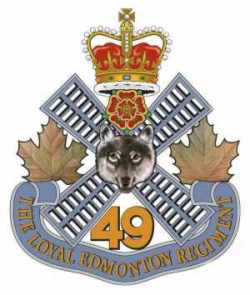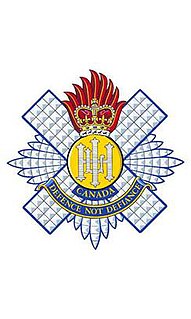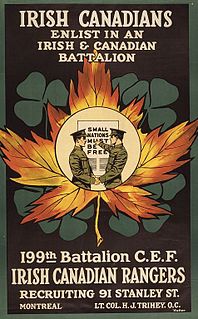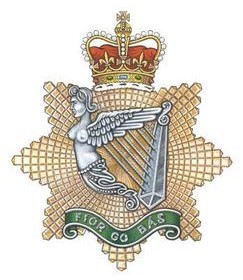Related Research Articles

The Royal Hamilton Light Infantry (RHLI) is a Primary Reserve infantry regiment of the Canadian Army, based at John Weir Foote VC Armoury in Hamilton, Ontario. The RHLI is part of 31 Canadian Brigade Group, which is part of 4th Canadian Division.

The Loyal Edmonton Regiment, or LER, is a Primary Reserve infantry unit of the Canadian Forces based in Edmonton, Alberta. The LER is part of 3rd Canadian Division's 41 Canadian Brigade Group. They are colloquially known as "The Loyal Eddies".

The Royal Highland Fusiliers of Canada is a Primary Reserve light infantry regiment of the Canadian Army, with companies in Cambridge and Kitchener, and is an infantry sub-unit of 31 Canadian Brigade Group, headquartered in London, Ontario. The Princess Margaret, Countess of Snowdon and The Prince Andrew, Duke of York, as members of the Canadian Royal Family, acted as Colonel-in-Chief

The Brockville Rifles is a Primary Reserve infantry regiment of the Canadian Army. The unit is a part of the 33 Canadian Brigade Group, 4th Canadian Division. It is fifteenth in the order of precedence of Canadian Army Infantry Regiments.

The Algonquin Regiment is a primary reserve infantry regiment of the Canadian Army comprising two companies. A Company is located in North Bay, Ontario, and B Company is located in Timmins, Ontario. The regiment falls under the command of the 4th Canadian Division's 33 Canadian Brigade Group.

The Canadian Scottish Regiment is a Primary Reserve infantry regiment of the Canadian Army based on Vancouver Island in British Columbia.
The 183rd Battalion, CEF was a unit in the Canadian Expeditionary Force during the First World War. Based in Winnipeg, Manitoba, the unit began recruiting during the winter of 1915/16 throughout the Province of Manitoba. After sailing to England in October 1916, the battalion was broken up in November 1916 and its men transferred to the following units: 100th Battalion, CEF, 107th Battalion, CEF, 108th Battalion, CEF, and the 144th Battalion, CEF. The 183rd Battalion, CEF had one Officer Commanding: Lieut-Col. W. T. Edgecombe.

The 207th (Carleton) Battalion, CEF was a battalion of the First World War Canadian Expeditionary Force.
The 127th Battalion, CEF was a unit in the Canadian Expeditionary Force during the First World War. Based in Toronto, Ontario, the unit began recruiting in late 1915 in York County. After sailing to England in August 1916, the battalion was redesignated the 2nd Battalion, Canadian Railway Troops on November 8, 1916. The 127th Battalion, CEF had one Officer Commanding: Lieut-Col. F. F. Clarke, DSO.

The 133rd Battalion, CEF was a unit in the Canadian Expeditionary Force during the First World War.
The 143rd Battalion, CEF was a unit in the Canadian Expeditionary Force during the First World War. Based in Victoria, British Columbia, the unit began recruiting in 1916 throughout Western Canada. Bantam units were organized to recruit men who were shorter than the standard 5-foot-4-inch (163 cm) height required for joining the army. By the time they were fully formed, however, only about half of the men were under that standard height as they could not find enough short men to enlist.

The 199th Battalion, CEF was a unit in the Canadian Expeditionary Force (CEF) during the First World War.
The 211th Battalion, CEF was a unit in the Canadian Expeditionary Force during the First World War. Based in Vancouver, British Columbia, the unit began recruiting in early 1916 throughout British Columbia and Alberta. After sailing to England in December 1916, the battalion was transferred to the 8th Battalion, Canadian Railway Troops in March 1917. The 211th Battalion, CEF had one Officer Commanding: Lieut-Col. W. M. Sage.
The 218th Battalion, CEF, was a unit in the Canadian Expeditionary Force during the First World War. Based in Edmonton, Alberta, the unit began recruiting in early 1916 in that city.
The 226th Battalion, CEF was a unit in the Canadian Expeditionary Force during the First World War. Based in Dauphin, Manitoba, the unit began recruiting in March of 1916 in the area of Dauphin and Minnedosa, Manitoba. After sailing to England in December 1916, the battalion was absorbed into the 14th Reserve Battalion on April 7, 1917. The 226th Battalion, CEF had one Officer Commanding: Lieut-Col. R. A. Gillespie.

The 228th Battalion, CEF was a unit in the Canadian Expeditionary Force during the First World War. Based in North Bay, Ontario, the unit began recruiting in early 1916 in Nipissing and Sudbury. After sailing to England in December 1916, the battalion became the 6th Battalion, Canadian Railway Troops, on 8 March 1917. The 228th Battalion had one officer commanding: Lieutenant-Colonel Archie Earchman.

The 2nd Battalion, Irish Regiment of Canada is a Primary Reserve infantry regiment of the Canadian Army based in Sudbury, Ontario. It is part of the 4th Canadian Division's 33 Canadian Brigade Group.

The Queen's York Rangers (RCAC) is a Canadian Army Primary Reserve Royal Canadian Armoured Corps regiment based in Toronto and Aurora. The regiment is part of 4th Canadian Division's 32 Canadian Brigade Group. The regiment consists of one reconnaissance squadron, and the Headquarters and Training Squadron. The regimental family also includes The Queen's York Rangers Band (volunteer) along with two Royal Canadian Army Cadet corps and a Royal Canadian Air Cadet squadron. The unit mottos are pristinae virtutis memor – "remembering their glories in former days" – and celer et audax – "swift and bold." Among its own members and those of other regiments, the unit is referred to as the Rangers. The name is abbreviated as QY Rang, and sometimes pronounced KWY-rang.
The 256th Battalion, CEF was a unit in the Canadian Expeditionary Force during the First World War. Based in Toronto, Ontario, the unit began recruiting in late 1916 in that city. The unit later became the 10th Battalion, Canadian Railway Troops. The battalion received no battle honours and was disbanded on 15 September 1920. The 256th Battalion, CEF had one Officer Commanding: Lieut-Col. W. A. McConnell.
The Corps of Canadian Railway Troops were part of the Canadian Expeditionary Force (CEF) during World War I. Although Canadian railway units had been arriving in France since August 1915, it was not until March 1917 that the units were placed under a unified headquarters named the Canadian Railway Troops. They were redesignated as the "Corps of ..." on 23 April 1918. The corps was disbanded along with the rest of the CEF on 1 November 1920.
References
- ↑ Meek, John F. (1971). Over the Top! The Canadian Infantry in the First World War (PDF). Orangeville, Ont.: Published by the author.